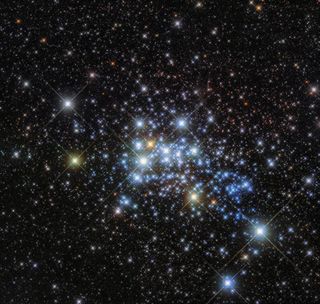What is the biggest star in the universe?
The biggest star in the universe makes our sun look tiny speck.

The biggest star in the universe (that we know of), UY Scuti is a variable hypergiant with a radius around 1,700 times larger than the radius of the sun.
To put that in perspective, the volume of almost 5 billion suns could fit inside a sphere the size of UY Scuti.
Our sun is enormous — more than a million Earths could fit inside of it. But on a stellar scale, it could be swallowed up by about half of all stars observed so far — especially stars like UY Scuti.
Related: How many stars are in the universe?
Who discovered UY Scuti?
In 1860, German astronomers at the Bonn Observatory first cataloged UY Scuti, at the time naming it BD -12 5055, reported Astronomy Magazine. During a second observation, astronomers realized it grows brighter and dimmer over a 740-day period, leading to its classification as a variable star.
Where is UY Scuti?
The star lies near the center of the Milky Way, roughly 9,500 light-years away from Earth. Located within the constellation Scutum, UY Scuti is a hypergiant star. Hypergiants — larger than supergiants and giants — are rare stars that shine very brightly. They lose much of their mass through fast-moving stellar winds.
Related: Hypergiant star's weight loss secrets revealed
How do you measure the size of a star?

However, all stellar sizes are estimates.
"The complication with stars is that they have diffuse edges," astronomer Jillian Scudder of the University of Sussex wrote for The Conversation. "Most stars don't have a rigid surface where the gas ends and vacuum begins, which would have served as a harsh dividing line and easy marker of the end of the star."
Instead, astronomers rely on a star's photosphere to determine its size. The photosphere is where the star becomes transparent to light and the particles of light, or photons, can escape the star.
"As far as an astrophysicist is concerned, this is the surface of the star, as this is the point at which photons can leave the star," Scudder wrote.
If UY Scuti replaced the sun in the center of the solar system, its photosphere would extend just beyond the orbit of Jupiter. The nebula of gas ejected from the star extends far beyond the orbit of Pluto, to 400 times the distance between the Earth and the sun.
Other big stars

UY Scuti's large radius does not make it the most massive, or heaviest, star. That honor goes to R136a1, which weighs in at about 300 times the mass of the sun but only about 30 solar radii. UY Scuti, in comparison, is only about 30 times the mass of the sun, but far greater in volume.
Size comparisons are still more complicated because UY Scuti doesn't remain stagnant. Scudder pointed out that the star varies in brightness as it varies in radius. And the measurement we have now has a margin of error of about 192 solar radii. The variation or margin of error each could allow other stars to beat out UY Scuti in the race for size. In fact, there are as many as 30 stars whose radii approach or surpass UY Scuti's smallest estimated size, so the behemoth shouldn't sit too securely on its throne.
Which star would take UY Scuti's place if its size were reevaluated? Here are a few that could take the crown from the giant currently measured at 1,700 times the width of the sun:
- WOH G64 was once thought to measure a whopping 3,000 times the width of the sun. Newer measurements put it at around 1,504 suns wide instead, according to a 2009 paper published in The Astronomical Journal. It is a red hypergiant star in the Large Magellanic Cloud, which is a satellite galaxy of the Milky Way. Like UY Scuti, WOH G64 varies in brightness.
- Westerlund 1-26, which measures more than 1,500 times the width of the sun, according to NASA.
- NML Cygni is measured at 1,639 times the width of the sun, according to a 2012 paper in the journal Astronomy and Astrophysics.
- KY Cygni measures close to 1,033 times the width of the sun, according to a 2020 paper in the journal Astrophysics of Galaxies.
- VY Canis Majoris has been most recently measured to be about 1,420 times the width of the sun, in a 2012 paper in the journal Solar and Stellar Astrophysics. This red hypergiant star was once estimated to be 1,800 to 2,200 times the width of the sun, but new measurements brought it down to size. However, some sources still list it as the largest star.
Additional resources
If you're curious about the smallest known star in the universe check out this interesting article from BBC Science Focus. Learn more about measuring stellar sizes with these resources from the Rochester Institute of Technology and Study.com.
Bibliography
- Comerón, F., A. A. Djupvik, N. Schneider, and A. Pasquali. "The Historical Record of Massive Star Formation in Cygnus." Astronomy & Astrophysics 644 (December 2020): A62. https://doi.org/10.1051/0004-6361/202039188.
- Hille, Karl. "Hubble Homes In on a Hypergiant's Home." Text. NASA, March 10, 2017. http://www.nasa.gov/image-feature/goddard/2017/hubble-hones-in-on-a-hypergiants-home.
- Levesque, Emily M., Philip Massey, Bertrand Plez, and Knut A. G. Olsen. "The Physical Properties Of The Red Supergiant WOH G64: The Largest Star Known?" The Astronomical Journal 137, no. 6 (June 1, 2009): 4744–52. https://doi.org/10.1088/0004-6256/137/6/4744.
- Parks, Jake. "Meet the Most Extreme Stars." Astronomy.com, September 23, 2020. https://astronomy.com/magazine/news/2020/09/the-most-extreme-stars-in-the-universe.
- Scudder, Jillian. "How Big Is the Biggest Star We Have Ever Found?" The Conversation, February 9, 2015. http://theconversation.com/how-big-is-the-biggest-star-we-have-ever-found-37304.
- Wittkowski, M., P. H. Hauschildt, B. Arroyo Torres, and J. M. Marcaide. "Fundamental Properties and Atmospheric Structure of the Red Supergiant VY CMa Based on VLTI/AMBER Spectro-Interferometry." Astronomy & Astrophysics 540 (April 2012): L12. https://doi.org/10.1051/0004-6361/201219126.
- Zhang, B., M. J. Reid, K. M. Menten, X. W. Zheng, and A. Brunthaler. "The Distance and Size of the Red Hypergiant NML Cygni from VLBA and VLA Astrometry." Astronomy & Astrophysics 544 (August 1, 2012): A42. https://doi.org/10.1051/0004-6361/201219587.
Join our Space Forums to keep talking space on the latest missions, night sky and more! And if you have a news tip, correction or comment, let us know at: community@space.com.
Get the Space.com Newsletter
Breaking space news, the latest updates on rocket launches, skywatching events and more!

Nola Taylor Tillman is a contributing writer for Space.com. She loves all things space and astronomy-related, and enjoys the opportunity to learn more. She has a Bachelor’s degree in English and Astrophysics from Agnes Scott college and served as an intern at Sky & Telescope magazine. In her free time, she homeschools her four children. Follow her on Twitter at @NolaTRedd
- Vicky SteinContributing Writer
